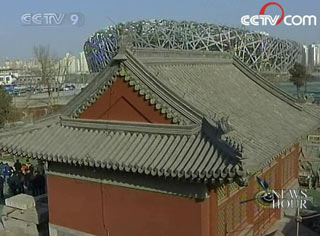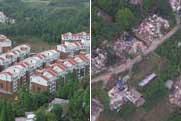China
Beijing restores traditional past
WATCH VIDEO
Source: CCTV.com | 01-09-2008 13:48
Special Report: 2008 Beijing Olympic GamesAs China modernizes, it faces an ongoing challenge to preserve its rich cultural legacy and historical sites -- in the face of onrushing development.
 |
| This temple stands next to the National Stadium, a new venue built for the Beijing Games. The planned site had to be moved 100 meters so the temple could be preserved. |
The current restoration of Beijing's hutongs, or old alleys, is part of the government's campaign to restore the ancient capital's history.
If there's anything that can reflect genuine Beijing culture, it's the hutong. Seventy-four year old Liu Guizhen has lived in one such alley for almost six decades. Her bungalow was completely rebuilt several months ago, preserving its traditional look.
Courtyard resident Liu Guizhen said, "The restoration is the best thing that ever happened to old homes since they were built. Some were destroyed in the past, and the ones that survived were either changed to different layouts or are crumbling. I was worried that all hutongs would disappear during my lifetime. But it's not a concern anymore."
Hutongs have not been alone in facing these challenges.
Some other ancient structures are also in disrepair. Or have to give way to development along with memories passed along through the generations.
In response to public concern,Beijing municipal government slowed the pace of demolition in the late 1990's, setting aside forty protected zones in the city center. And restoring history became a much higher priority.
Kong Fanzhi, director of Beijing Cultural Heritage, said, "The trend of development in Beijing is toward an international metropolis. But as an ancient city, its rich heritage also needs to be preserved. We are seeking an equilibrium."
Starting in 2002, a series of regulations were drafted to preserve the city's heritage. Traditional houses were no longer allowed to be razed. And authorities began strictly controlling the construction of new buildings.
And there's been no exception for the flurry of activity ahead of the 2008 Olympics. This temple stands next to the National Stadium, a new venue built for the Beijing Games. The planned site had to be moved 100 meters so the temple could be preserved.
This is just one example of China's promise of organizing a cultural Olympics.
Tourist Michael Beegan said, "I think preserving the old is valuable, as well as the new going up. Maybe some of the new building can be created in the old structures. For me, genuine, but the Chinese also have their right to develop."
The citywide campaign to restore its historic landscape means there is a future for the past.
For Beijing's inner city dwellers, ancient buildings are living memory. Gray bricks, roof tiles, and the imperial color are part of the city's heritage. And for foreign visitors, historical sites are a way to understand the city's past. A balance between a modern yet historical Beijing is perhaps the best image to showcase to the world.
Editor:Zhang Ning



